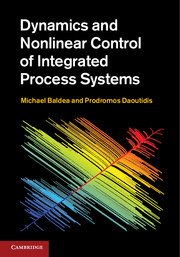6 - Process systems with energy recycling
from Part III - Process systems with energy integration
Published online by Cambridge University Press: 05 September 2012
Summary
Introduction
The previous chapters have concentrated on analyzing the material-balance dynamics of several classes of integrated process systems. We demonstrated that the dynamic behavior of the systems considered exhibits several time scales and described a method for the derivation of reduced-order models describing the dynamics in each time scale. Also, a hierarchical controller design framework was introduced, with distributed control of the fast dynamics and supervisory control of the dynamics at the systems level.
In what follows, we focus on the dynamic features associated with energy integration, a ubiquitous design feature in the process and energy industries. Energy-integrated designs are motivated by the high cost of energy and the corresponding need to minimize fuel and utility usage. Pairing energy generation and consumption within the same plant is an effective means to this end, and can be implemented in numerous ways, including the use of feed–effluent heat-exchange, plant-wide heat exchanger networks, heat pumping, and heat integration and thermal coupling of distillation columns.
Energy-integrated designs invariably introduce a dynamic coupling between the process units. Several authors have documented a positive-feedback effect due to recycling of energy, which can lead to an intricate dynamic behavior, featuring, e.g., an inverse response or open-loop instability (Morud and Skogestad 1994, 1996, Bildea and Dimian 1998, Jacobsen and Berezowski 1998, Mizsey et al. 1998, Morud and Skogestad 1998, Reyes and Luyben 2000a, Chen and Yu 2003).
The present chapter considers processes in which energy recycling and recovery is significant in comparison with any available energy sources and/or sinks, as well as with any energy input through the feed stream.
- Type
- Chapter
- Information
- Dynamics and Nonlinear Control of Integrated Process Systems , pp. 143 - 176Publisher: Cambridge University PressPrint publication year: 2012

